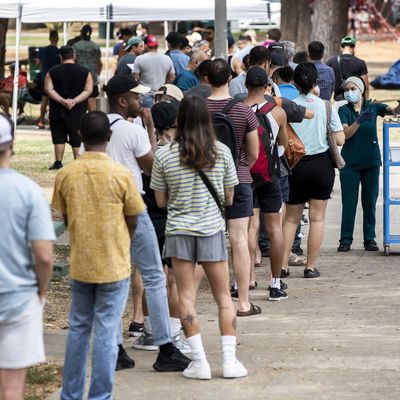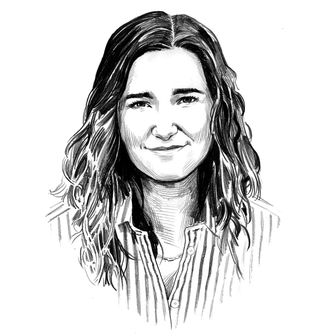
In recent months, outbreaks of monkeypox — a rare viral disease that has previously appeared mostly in central and western African countries, where it is endemic — have surfaced in more than 88 countries including Spain, Portugal, Italy, Sweden, Germany, Canada, Australia, and the United States. The CDC has now reported several hundred cases across 48 states, and on July 23, the World Health Organization declared the virus a public-health emergency of international concern, a rare designation that calls for a coordinated international response in order to prevent a pandemic. On August 4, President Biden followed suit, declaring the monkeypox outbreak a public-health emergency in the United States.
The form of monkeypox currently in circulation is thought to be mild and does not spread easily between people: Transmission requires close contact with an infected individual, animal, body fluids, or contaminated surface. The CDC has said monkeypox cases in the U.S. are mainly occurring in men who have sex with men, but other people are also getting infected. On July 25, the agency confirmed two cases of monkeypox in children, who they say likely contracted the virus through household transmission.
Though the CDC has expressed that the risk to the general public remains low, President Joe Biden has said the agency is working on widening access to the vaccine. In New York City, where roughly 25 percent of U.S. monkeypox cases have been identified, officials opened up 23,000 appointment slots for the vaccine on Thursday, August 4. New York governor Kathy Hochul recently announced that the state will receive 110,000 additional doses in the coming weeks, with 80,000 of those doses directed to New York City specifically.
Here is what we know about the monkeypox cases so far.
What are the symptoms of monkeypox?
While monkeypox is increasingly associated with large, pus-filled lesions as pictured in news stories, there are a number of other symptoms associated with this virus. “The disease usually starts with nonspecific symptoms similar to what you might see with influenza: fever, headache, muscle aches,” says Adam Ratner, the director of pediatric infectious diseases at NYU Langone Health. “People who get it also tend to have large lymph nodes under their jaw.”
However, these symptoms aren’t always present or noticeable, says Bernard Camins, the medical director for infection prevention at the Mount Sinai Health System. “Some patients are presenting with just a rash” or localized lesions, he explains. “It may be that the syndrome was so mild that they didn’t feel anything, and then the rash suddenly appears.”
Monkeypox rash tends to appear first on the face or torso (though they tend to spread elsewhere) and “start as flat reddish areas that then become raised and then become fluid filled,” says Ratner. In some cases, these lesions can be very painful, and scarring is possible.
How is monkeypox spread?
Monkeypox can spread through large respiratory droplets, which “travel shorter distances than aerosols do and don’t hang out in the air as much as aerosols do,” says Ratner. The monkeypox virus can also be spread through contact with lesions, especially if there is broken skin.
Though a number of current outbreaks can be traced to networks of men who have sex with men, monkeypox is not classified as a sexually transmitted disease in the traditional sense — it’s just that sex is one form of close contact through which monkeypox can be transmitted. “Right now, there is a sexually transmitted disease component, but you don’t have to have sex with someone to get it,” says Camins, adding that people who live with infected persons would also be at risk.
Though concern surrounding monkeypox is not unreasonable, it’s likely amplified because of the ongoing COVID-19 pandemic, which Camins emphasizes is a very different virus. “Monkeypox is certainly not as contagious as smallpox, chicken pox, or COVID for that matter,” he says. “There is a respiratory component, but these are large droplets, which means that wearing a mask can protect you.”
Is monkeypox deadly?
On the whole, monkeypox tends to be a mild disease, says Ratner. “I’m using ‘mild’ to mean ‘usually not life-threatening,’” he explains.
“There’s a central African version and a west African version” of monkeypox, Ratner adds. “To our best understanding through viral sequencing now, the cases we’re seeing now have all been of the west African kind, which is usually less severe.”
Mortality rates for these two types of monkeypox are generally cited as one percent for the west African type and 10 percent for the central African type, though Ratner cautions that the latter figure may be misleading: “Those numbers tend to be from outbreaks that are in places where there are higher numbers of malnourished individuals, and that’s a risk factor for severe disease, and immunocompromised people, which is also a risk factor.”
“Mortality is rare,” adds Camins. “The worrisome part isn’t the mortality but more so the length of time that people are contagious and that they’re contagious even before the rash appears. Because of stigma, and we’re seeing this now, if people don’t get that sick, patients with milder symptoms may not present for care or may not know for sure that they have monkeypox, and they might not isolate.”
How is monkeypox treated?
Anyone with a suspected case of monkeypox should seek medical attention, at which point they will likely be isolated. But most people who become infected with monkeypox won’t get very sick and may not benefit from treatment as a result, says Ratner. From start to finish, most cases of monkeypox last a couple of weeks.
In some cases, says Camins, doctors are prescribing TPOXX, but because this drug is still in clinical trials, it’s not always easy to get. “It can take providers two to three hours to fill out paperwork to get the patient treatment because it’s still under review,” he explains. Camins says it is unlikely there would be a mass vaccination campaign against monkeypox as the risk to the general public remains low.
What’s this about a monkeypox vaccine?
In recent weeks, public-health departments have parceled out doses of the Jynneos vaccine as they receive them from the national stockpile, but there is a shortage and demand exceeds supply. The vaccine is not available through traditional channels like pharmacies and doctors’ offices, and the piecemeal rollout has caused considerable frustration. U.S. health officials have said an additional 2.5 million doses should arrive late this year.
How can we prevent the spread of monkeypox?
People experiencing symptoms and/or who have been exposed to monkeypox should seek medical care as soon as possible, experts say. Both Ratner and Camins emphasize that better public awareness is needed in order to control the spread, and to ensure that at-risk groups are informed on best prevention practices.
According to Camins, there is still time to get the monkeypox outbreak under control. “I think there’s still time if we can make vaccines readily available,” he says. “It’s generally large cities that are reporting lots of cases. We have a very good public-health system in New York, but I worry about other areas where public-health infrastructure isn’t as robust. It’s encouraging that high-risk groups are coming out to get vaccinated when they are available.”
This post has been updated.





